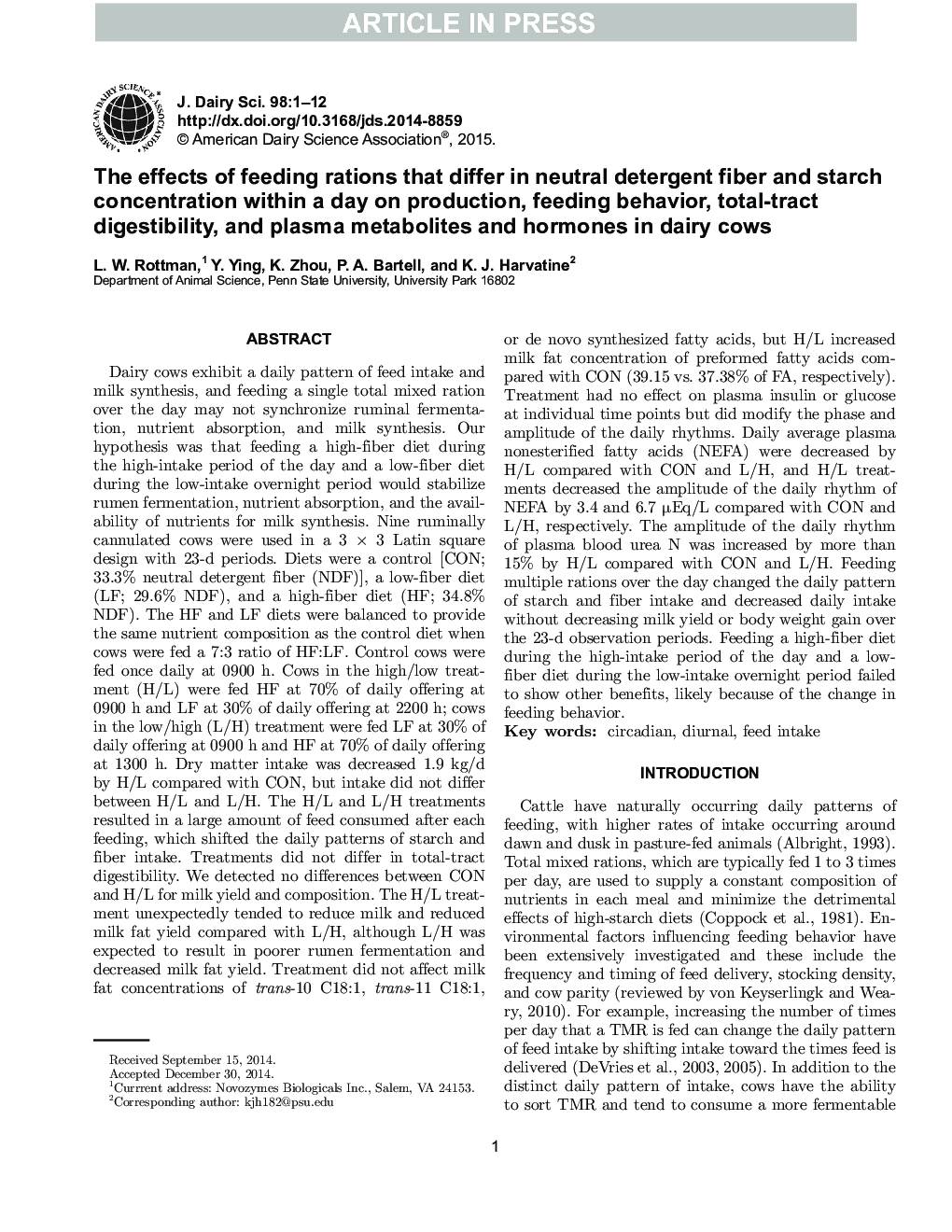| کد مقاله | کد نشریه | سال انتشار | مقاله انگلیسی | نسخه تمام متن |
|---|---|---|---|---|
| 10975291 | 1108032 | 2015 | 12 صفحه PDF | دانلود رایگان |
عنوان انگلیسی مقاله ISI
The effects of feeding rations that differ in neutral detergent fiber and starch concentration within a day on production, feeding behavior, total-tract digestibility, and plasma metabolites and hormones in dairy cows
ترجمه فارسی عنوان
اثرات تغذیه جیره که در فیبر مواد شوینده خنثی و غلظت نشاسته در یک روز بر تولید، رفتار تغذیه، هضم کامل کلسترول و متابولیت های پلاسما و هورمون در گاوهای شیری تفاوت دارد
دانلود مقاله + سفارش ترجمه
دانلود مقاله ISI انگلیسی
رایگان برای ایرانیان
کلمات کلیدی
روزانه روزانه مصرف خوراک،
موضوعات مرتبط
علوم زیستی و بیوفناوری
علوم کشاورزی و بیولوژیک
علوم دامی و جانورشناسی
چکیده انگلیسی
Dairy cows exhibit a daily pattern of feed intake and milk synthesis, and feeding a single total mixed ration over the day may not synchronize ruminal fermentation, nutrient absorption, and milk synthesis. Our hypothesis was that feeding a high-fiber diet during the high-intake period of the day and a low-fiber diet during the low-intake overnight period would stabilize rumen fermentation, nutrient absorption, and the availability of nutrients for milk synthesis. Nine ruminally cannulated cows were used in a 3 Ã 3 Latin square design with 23-d periods. Diets were a control [CON; 33.3% neutral detergent fiber (NDF)], a low-fiber diet (LF; 29.6% NDF), and a high-fiber diet (HF; 34.8% NDF). The HF and LF diets were balanced to provide the same nutrient composition as the control diet when cows were fed a 7:3 ratio of HF:LF. Control cows were fed once daily at 0900 h. Cows in the high/low treatment (H/L) were fed HF at 70% of daily offering at 0900 h and LF at 30% of daily offering at 2200 h; cows in the low/high (L/H) treatment were fed LF at 30% of daily offering at 0900 h and HF at 70% of daily offering at 1300 h. Dry matter intake was decreased 1.9 kg/d by H/L compared with CON, but intake did not differ between H/L and L/H. The H/L and L/H treatments resulted in a large amount of feed consumed after each feeding, which shifted the daily patterns of starch and fiber intake. Treatments did not differ in total-tract digestibility. We detected no differences between CON and H/L for milk yield and composition. The H/L treatment unexpectedly tended to reduce milk and reduced milk fat yield compared with L/H, although L/H was expected to result in poorer rumen fermentation and decreased milk fat yield. Treatment did not affect milk fat concentrations of trans-10 C18:1, trans-11 C18:1, or de novo synthesized fatty acids, but H/L increased milk fat concentration of preformed fatty acids compared with CON (39.15 vs. 37.38% of FA, respectively). Treatment had no effect on plasma insulin or glucose at individual time points but did modify the phase and amplitude of the daily rhythms. Daily average plasma nonesterified fatty acids (NEFA) were decreased by H/L compared with CON and L/H, and H/L treatments decreased the amplitude of the daily rhythm of NEFA by 3.4 and 6.7 μEq/L compared with CON and L/H, respectively. The amplitude of the daily rhythm of plasma blood urea N was increased by more than 15% by H/L compared with CON and L/H. Feeding multiple rations over the day changed the daily pattern of starch and fiber intake and decreased daily intake without decreasing milk yield or body weight gain over the 23-d observation periods. Feeding a high-fiber diet during the high-intake period of the day and a low-fiber diet during the low-intake overnight period failed to show other benefits, likely because of the change in feeding behavior.
ناشر
Database: Elsevier - ScienceDirect (ساینس دایرکت)
Journal: Journal of Dairy Science - Volume 98, Issue 7, July 2015, Pages 4673-4684
Journal: Journal of Dairy Science - Volume 98, Issue 7, July 2015, Pages 4673-4684
نویسندگان
L.W. Rottman, Y. Ying, K. Zhou, P.A. Bartell, K.J. Harvatine,
